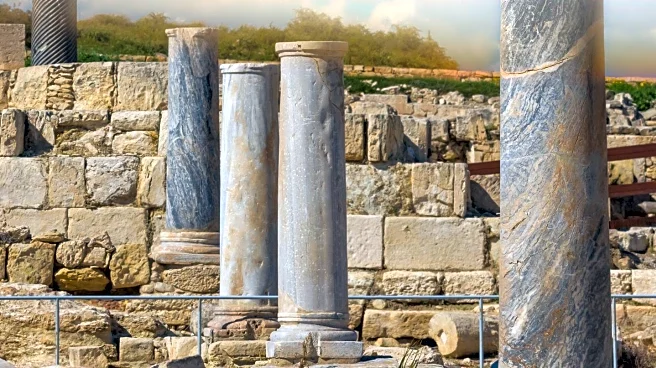What's Happening?
Archaeologists have discovered an ancient mosaic on the slopes of Sussita, overlooking the Sea of Galilee, which dates back 1,600 years and bears the inscription 'Peace to the elderly.' This find is considered the earliest documented evidence of a nursing home in recorded history. The mosaic, embedded within a colorful medallion, was uncovered during systematic archaeological digs at Sussita National Park, a site known for its historical significance during the Byzantine period. The city of Sussita, also known as Hippos, was a major Christian hub, hosting a bishop and several churches. Researchers, including Dr. Michael Eisenberg from the Zinman Institute of Archaeology at the University of Haifa, have been investigating whether the building housing the mosaic functioned as a dedicated elderly care facility. The mosaic's location and surrounding iconography suggest a spiritual and social purpose, indicating an organized community effort to honor and support the elderly.
Why It's Important?
The discovery of this mosaic provides significant insights into the social structures and values of Byzantine-era Israel, particularly regarding the care of the elderly. It challenges the notion that elderly care is a modern concept, showing that such institutions existed 1,600 years ago. This find highlights the communal and spiritual roles within the Christian city of Sussita, reflecting its social values and the shift from family-based care to organized community efforts. The mosaic's inscription directly addressing the elderly offers a rare glimpse into the daily lives and societal roles of seniors in antiquity. This discovery not only enriches historical understanding but also underscores the longstanding human concern for elderly care.
What's Next?
Further analysis and conservation efforts are expected to continue at the excavation site, with researchers aiming to uncover more details about the building's function and its role within the Byzantine community. The findings may prompt additional archaeological investigations in the region to explore similar sites and artifacts. Scholars and historians will likely delve deeper into Byzantine records to compare and contrast this evidence with other historical mentions of elderly care institutions. The discovery may also inspire modern discussions on the evolution of elderly care and its historical roots.
Beyond the Headlines
This discovery raises ethical and cultural questions about the treatment and perception of the elderly throughout history. It suggests that societal values regarding elderly care have deep historical roots, potentially influencing contemporary practices and policies. The mosaic's spiritual and social significance may also prompt discussions on the integration of religious and communal values in public life, both historically and in modern contexts.













